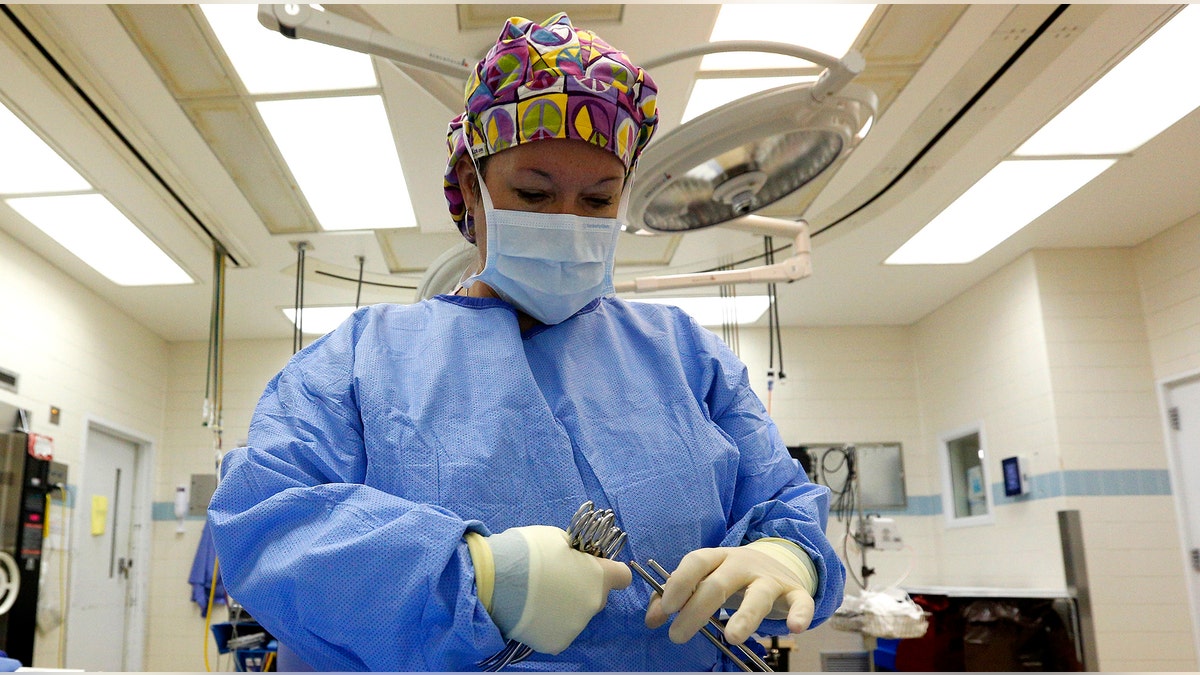
Surgical Tech Melissa Ellis prepares an OR room in the University of Mississippi Medical Center in Jackson, Mississippi October 4, 2013. Mississippi is one of at least 20 states that has decided not to expand Medicaid under the Affordable Care Act, better known as "Obamacare". REUTERS/Jonathan Bachman (UNITED STATES - Tags: HEALTH POLITICS BUSINESS) - RTR3FLTD (REUTERS)
Tax reform legislation signed into law by President Trump in December, which will lower taxes for most Americans this year, unfortunately did nothing to stop billions of dollars in new taxes under ObamaCare from hitting millions of Americans in the wallet.
This is because while the tax reform law weakens part of ObamaCare – by basically ending the mandate requiring individuals to buy health insurance coverage – important parts of the health-care law still remain in effect. These include: a big expansion of Medicaid, the federal-state health program serving the poor; federal regulations on health insurance markets; and several taxes to finance the health-care law.
Three of the ObamaCare taxes have been targeted for elimination by a bipartisan coalition of lawmakers who are concerned about raising the cost of health insurance for so many Americans. While the official name of ObamaCare is the Affordable Care Act, the new taxes harm rather than protect consumers and make health insurance less affordable.
The ObamaCare taxes being targeted by opponents are: the so-called “Cadillac tax” on some high-value health insurance policies; an excise tax on medical devices; and a 4 to 6 percent tax on some insurance policies when they are sold. While the “Cadillac tax” hasn’t gone into effect, both the health insurance and medical device taxes became effective Jan. 1.
Although Republicans did not create ObamaCare, they are in a golden position to do something about the rising premiums that have resulted.
The health insurance tax is troubling because it’s paid for directly by consumers, in the form of higher premiums. So millions of us will take a direct hit, even though most people who will be paying for the tax increase don’t even realize it.
Lawmakers and President Trump should consider immediately ending the health insurance tax, whether as part of their discussions regarding a spending package for the remainder of 2018 or as part of additional health-care reform efforts.
In addition to the taxes imposed by ObamaCare, there are a number of factors that influence how much consumers generally pay for health insurance.
For example, the premium is impacted by the specific benefits and health-care providers that are part of the plan. The premium is also affected by the relative health or sickness of others who participate in an insurance plan. Plans that include a larger proportion of sicker beneficiaries overall will be more expensive, while plans with a healthier mix of enrollees are cheaper.
The new health insurance tax applies to so-called “fully-insured” health insurance plans. It will be paid by: consumers who purchase their coverage on the individual market (including ObamaCare’s health insurance exchanges); many employees of small businesses that furnish coverage; and even some people who get their health insurance through large employers.
The new health insurance tax also applies to seniors enrolled in Medicare Advantage or Medicare prescription drug plans, as well as low-income Americans in Medicaid managed care plans.
The Congressional Budget Office estimates that the tax will raise about $13 billion in revenue in 2018 alone, and about $145 billion over the next 10 years. But these numbers don’t tell the full story of how the health insurance tax impacts families, small businesses and taxpayers across America.
A study last year by Oliver Wyman Health found that the health insurance tax will increase annual health insurance premiums in 2018 by $158 per person in the individual market; about $500 per family for those getting coverage through many small employers and some large employers; and $245 for each Medicare Advantage member.
These increases will accelerate in 2019 and beyond. So over the next 10 years, the study concludes that individual market beneficiaries will pay over $2,000 more in premiums; families getting their coverage through small employers will pay over $6,000 more; and Medicare Advantage members will pay over $3,000 more.
Medicaid managed-care enrollees will see premium increases of $181 in 2018 and an estimated $2,370 over the next 10 years. These costs won’t be borne by the low-income beneficiaries of the program. Instead, states and their taxpayers will foot the bill.
As insurance premiums rise – in part because of the health insurance tax – healthier consumers are more likely to forego health insurance. This concept, known as adverse selection, will leave only sicker consumers – particularly in the individual and small-group marketplaces.
With a higher proportion of sicker individuals on health insurance rolls, the cost of an insurance policy will become even more unaffordable. The effective elimination of the individual mandate to purchase health insurance could actually worsen this trend. This is because there will be even less economic incentive for healthy consumers, in particular, to buy coverage. This will tend to boost premiums even more for those who are sicker or need health insurance coverage.
Republicans, then, have both a policy and political imperative to get rid of ObamaCare’s health insurance tax. While the tax certainly isn’t the only reason that many consumers are experiencing higher premiums this year, it is an important factor.
Although Republicans did not create ObamaCare, they are in a golden position to do something about the rising premiums that have resulted. A failure to do so may hurt congressional Republicans when they come before the voters in this November’s midterm elections. And that’s a risk they shouldn’t take.




















